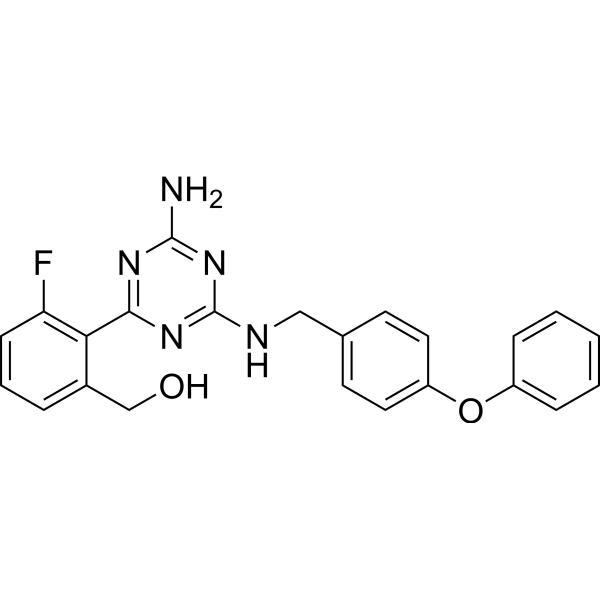Physicochemical Properties
| Molecular Formula | C23H20FN5O2 |
| Molecular Weight | 417.44 |
| Exact Mass | 417.16 |
| CAS # | 2375070-79-2 |
| PubChem CID | 139030523 |
| Appearance | White to off-white solid powder |
| Density | 1.3±0.1 g/cm3 |
| Boiling Point | 561.7±60.0 °C at 760 mmHg |
| Flash Point | 293.5±32.9 °C |
| Vapour Pressure | 0.0±1.6 mmHg at 25°C |
| Index of Refraction | 1.659 |
| LogP | 2.68 |
| Hydrogen Bond Donor Count | 3 |
| Hydrogen Bond Acceptor Count | 8 |
| Rotatable Bond Count | 7 |
| Heavy Atom Count | 31 |
| Complexity | 530 |
| Defined Atom Stereocenter Count | 0 |
| InChi Key | KKHDNAZPEMYUNO-UHFFFAOYSA-N |
| InChi Code | InChI=1S/C23H20FN5O2/c24-19-8-4-5-16(14-30)20(19)21-27-22(25)29-23(28-21)26-13-15-9-11-18(12-10-15)31-17-6-2-1-3-7-17/h1-12,30H,13-14H2,(H3,25,26,27,28,29) |
| Chemical Name | [2-[4-amino-6-[(4-phenoxyphenyl)methylamino]-1,3,5-triazin-2-yl]-3-fluorophenyl]methanol |
| HS Tariff Code | 2934.99.9001 |
| Storage |
Powder-20°C 3 years 4°C 2 years In solvent -80°C 6 months -20°C 1 month |
| Shipping Condition | Room temperature (This product is stable at ambient temperature for a few days during ordinary shipping and time spent in Customs) |
Biological Activity
| ln Vitro | 5-HT2B has a moderate binding affinity to MS48107 (compound 71) with a Ki value of 219 nM. MS48107 exhibits mild antagonist activity at 5-HT2B receptors, with a Ki value of 310 nM, but no agonist activity at these receptors[1]. Compound 71, MS48107, has agonistic action exclusively at the MT1 and MT2 receptors. At the MT1 receptor, MS48107 has mild complete agonist activity (EC50 = 320 nM), while at the MT2 receptor, its partial agonist activity is weak (EC50 = 540 nM). has modest affinity for binding to the MT1 (5900 nM) and MT2 (1100 nM) receptors[1]. |
| ln Vivo | A single intraperitoneal injection at a dose of 25 mg/kg for MS48107 (compound 71) causes high exposure levels (above 10 μM) in the brain and plasma within 0.5 hours in mice (Swiss Albino mice). For two hours, the high levels of compound exposure are sustained in the brain and plasma[1]. |
| References |
[1]. Design, Synthesis, and Characterization of Ogerin-Based Positive Allosteric Modulators for G Protein-Coupled Receptor 68 (GPR68). J Med Chem. 2019 Aug 22;62(16):7557-7574. |
Solubility Data
| Solubility (In Vitro) | DMSO: 100 mg/mL (239.56 mM) |
| Solubility (In Vivo) |
Solubility in Formulation 1: ≥ 2.5 mg/mL (5.99 mM) (saturation unknown) in 10% DMSO + 40% PEG300 + 5% Tween80 + 45% Saline (add these co-solvents sequentially from left to right, and one by one), clear solution. For example, if 1 mL of working solution is to be prepared, you can add 100 μL of 25.0 mg/mL clear DMSO stock solution to 400 μL PEG300 and mix evenly; then add 50 μL Tween-80 to the above solution and mix evenly; then add 450 μL normal saline to adjust the volume to 1 mL. Preparation of saline: Dissolve 0.9 g of sodium chloride in 100 mL ddH₂ O to obtain a clear solution. Solubility in Formulation 2: ≥ 2.5 mg/mL (5.99 mM) (saturation unknown) in 10% DMSO + 90% (20% SBE-β-CD in Saline) (add these co-solvents sequentially from left to right, and one by one), clear solution. For example, if 1 mL of working solution is to be prepared, you can add 100 μL of 25.0 mg/mL clear DMSO stock solution to 900 μL of 20% SBE-β-CD physiological saline solution and mix evenly. Preparation of 20% SBE-β-CD in Saline (4°C,1 week): Dissolve 2 g SBE-β-CD in 10 mL saline to obtain a clear solution. (Please use freshly prepared in vivo formulations for optimal results.) |
| Preparing Stock Solutions | 1 mg | 5 mg | 10 mg | |
| 1 mM | 2.3956 mL | 11.9778 mL | 23.9555 mL | |
| 5 mM | 0.4791 mL | 2.3956 mL | 4.7911 mL | |
| 10 mM | 0.2396 mL | 1.1978 mL | 2.3956 mL |
